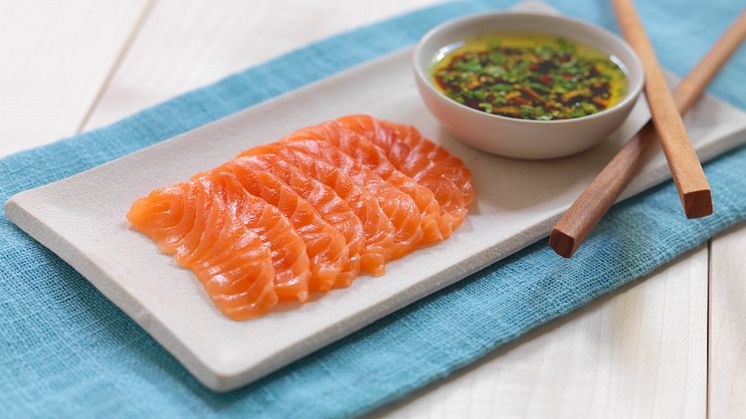
Press release -
Norwegian salmon opens up new markets
The value of Norwegian salmon in October exceeded the total export value for the whole of 2015. Export value increases were highest in Asia, North America and Africa.
In October, Norway exported 274,000 tonnes of seafood worth NOK 9.4 billion in October. A 12 per cent decrease in volume, and a value increase of 16 per cent compared to October 2015.
Year to date Norway has exported 2 million tonnes of seafood worth NOK 74.3 billion. This represents a 9 per cent decrease in volume, and a value increase of 16 per compared with the same period last year. This is just below the total value of the Norwegian seafood exports for the whole of 2015.
”At the same time salmon export prices are well above last year’s, the volume of Norwegian salmon exports has reduced in key European markets. In Spain, we see a volume decline of 28 per cent in October compared with October last year. In France we see a reduction of 12 per cent. However, we are seeing a shift in exports to high-end segments in Asia, America and Africa. The markets that pay the most for the Norwegian salmon are North America and Asia. Here the average prices in October were NOK 73.50 and NOK 70.80 per kg respectively for fresh whole salmon”, says communications director Geir Håvard Hanssen Norwegian Seafood Council.
Salmon and trout exports increase
In October, the Norwegian salmon industry exports by volume were 90,000 tonnes of salmon worth NOK 5.7 billion. This represents a 12 per cent decrease in volume, and a value increase of 23 per cent compared to October 2015.
Year to date the salmon industry has exported 800,000 tonnes of salmon, worth 49.2 billion kroner. This represents a 5,8 per cent decrease in volume, and a value increase of 29 per cent compared with the same period last year. Therefore, the export value of salmon has also exceeded the 2015 total by NOK 1.6 billion.
The average price achieved for whole fresh salmon in October was NOK 60.20 per kg compared with NOK 41.89 per kg in October 2015. Poland and France were the biggest importers of salmon from Norway in October.
In October, trout exports by volume amounted to 4,800 tonnes, worth NOK 308 million. This is a 15 per cent decrease in volume, and a value increase of 30 per cent compared to October 2015.
So far this year Norway has exported 60,000 tonnes of trout, worth NOK 3.3 billion. This is a 50 per cent volume increase, and a 88 per cent increase in value.
"For the first time since April 2015, Norwegian exports of fresh whole trout in October were at price levels which were higher than those for fresh whole salmon. In October, the average export price for fresh whole trout was NOK 61.22 per kg, compared to NOK 60.20 per kg for fresh whole salmon. Trout exports in October exceeded the total value of 2015 exports, at NOK 991 million”, says salmon analyst Paul Aandahl the Norwegian Seafood Council.
Belarus and Japan were the largest purchasers of Norwegian trout in October 2016.
Herring and mackerel exports both increased
The Norwegian pelagic industry exported 21,000 tonnes of herring worth NOK 277 million in October.
This is a volume increase of 31 per cent , and a value increase of 56 per cent compared to October 2015.
So far this year Norway has exported 179,000 tonnes of herring worth NOK 2.4 billion. An increase of 17 per cent in volume and a 45 per cent in value compared to the same period of last year. Poland and Ukraine were the largest markets for herring in October.
In October Norway mackerel exports reached 102,000 tonnes, worth NOK 1.5 billion. This is a 16 per cent decrease and a value increase of 12 per cent year-on-year. So far this year, Norwegian mackerel exports have totalled 252,000 tonnes worth NOK 3.3 billion. This is a 7 per cent decrease and an increase of 12 per cent in value compared to the same period last year. In October Japan and China were the largest markets for mackerel.
”The price of mackerel has risen by 40 per cent compared to October 2015. This suggests that our Norwegian exporters are able to realise high prices in the market. At the same time, the Japanese Yen has strengthened against the Norwegian kroner. This reduces the effect of rising mackerel prices in the Japanese market”, says analyst Kristin Lien from the Norwegian Seafood Council.
Fresh and frozen cod exports largely unchanged
October exports of fresh cod totalled 1,800 tonnes by volume, worth Norwegian NOK 71 million. This is consistent with the volume and value of exports in October 2015.
So far this year Norway has exported fresh cod, totalling 57,000 tonnes worth NOK 1.9 billion. This is consistent with the volume in the same period in 2015, and a 13 per cent value increase in value.
In October, Norway exported 8,600 tonnes frozen cod worth NOK 256 million. Again, this is the same volume and value as in 2015. So far this year Norway has exported 67,000 tonnes of frozen cod worth NOK 2.1 billion. This is an increase of 22 per cent in volume, and a 31 per cent increase in value compared to the same period last year.
Clipfish exports grow, salt fish contract
Norwegian clipfish industry exported 9,900 tonnes of clipfish worth NOK 456 million in October. This is an increase of 9 per cent in volume and a 4 per cent increase in value from October 2015. So far this year Norway clip fish exports have totalled 66,000 tonnes worth NOK 3 billion. This is a decrease of 8 per cent in volume and a decrease of 7 per cent in value from the same period in 2015.
Norwegian salted fish industry exports in October totalled 1,800 tonnes worth NOK 70 million. This is a decline of 14 per cent in volume and a 15 per cent decline in value from the same month in 2015. So far this year Norway exported 27,000 tonnes of salt fish worth NOK 1.1 billion. This is a 3,5 per cent decrease in volume and a value increase of 6 per cent compared to the same period last year.
”Norwegian clipfish exports have been affected by unstable markets. This applies to the African markets where fluctuating currency exchange has become a problem and the large clipfish market in Brazil. In Brazil, lower oil prices and economic turmoil has weakened consumer purchasing power. This impacts the demand for Norwegian clipfish, although we are now seeing signs of improvement”, says analyst Ingrid Kristine Pettersen with the Norwegian Seafood Council.
Topics
Categories
The Norwegian Seafood Council works with the Norwegian fisheries and aquaculture industries to develop markets for Norwegian seafood through local market intelligence, market development and reputational risk management. The Seafood Council is headquartered in Tromsø and maintains local representatives in twelve of Norway's most important international markets. The Norwegian seafood industry finances the activities of the Norwegian Seafood Council via a tariff on all Norwegian seafood exports.
The Norwegian Seafood Council is a public company owned by the Ministry of Trade, Industry and Fisheries.



